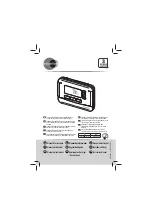
TRACE
MATE
Chapter 4
Operation
4.1
Alarms
When an alarm condition occurs, the form c dry alarm
contact reacts and the corresponding alarm LED comes
on to indicate the cause of the alarm. Fault diagnosis for
these alarms is listed below.
RTD Fail: If the RTD sensor is not connected or
shorted, RTD FAIL alarm LED will turn on. Check that
the RTD sensor is properly connected. This alarm is not
latched and will be reset as soon as the RTD is properly
connected. In the event of an RTD failure, the heater
output is turned off to prevent a runaway heating
situation.
Low Temperature: Once the actual temperature is below
the low temperature alarm setpoint, LO TEMP alarm
LED will turn on. This will normally indicate that the
heater circuit is not providing enough heat to maintain the
setpoint. When a system is first turned on this alarm may
be activated. It is particularly useful in taking corrective
action in freeze protection systems to prevent a burst
pipe. This alarm is not latched and will be reset as soon as
the alarm condition disappears.
High Temperature: Once the actual temperature is above
the high temperature alarm setpoint, HI TEMP alarm
LED will turn on. This alarm is not latched and will be
reset as soon as the alarm condition disappears.
Current Fail: This alarm is activated when the TraceMate
control calls for heat and a heater current less than the
current fail alarm setpoint flows. Either the continuity of
the wiring and heat tracing cable is defective or a very
small heater is being switched. In order to detect faults on
dormant systems with the TraceCheck feature, which
turns on the heaters for several seconds every 24 hours,
this alarm is latched. Thus, once the condition is detected,
the alarm will remain on until it is reset.
Ground Fault Trip: This alarm is activated when the
ground fault current is above the ground fault trip alarm
setpoint. A ground fault is a current to ground caused by
moisture, corrosion or insulation breakdown. Often the
amount of ground fault current is not enough to trip the
heater circuit breaker but could result in a serious fire
hazard, especially with self-regulating cable.
When a ground fault is detected, the heater will be
switched off, even if the control is calling for heat. This
eliminates the need for an expensive ground fault circuit
breaker. Large ground fault currents will trip the heater
circuit breaker, so an intentional time delay is allowed for
the breaker to clear high fault currents, which can occur
on solidly grounded systems.
Since the heater may be shut off after a ground fault, it is
very important that the alarm outputs be used so
corrective action can be taken quickly enough to prevent
a process shutdown due to the loss of heat to a pipe.
Ground fault detection only works with resistance or
solidly grounded systems. If the system is ungrounded, it
must be grounded or an artificial ground must be created
by means of a zip-zag transformer. Once a ground fault
condition is detected, it remains latched until it is reset.
Status Indicators
Power On Indicator: When incoming voltage is applied
to the TraceMate, the green PWR ON indicator LED
should be on. If this LED is not on, check that the
appropriate voltage is present by connecting a meter
across terminals 1 and 2. If voltage is present and the
LED is off, the controller should be replaced and sent to
the factory for service.
Heater On Indicator: Whenever the heater is on, the green
HTR ON indicator LED will be on. This is useful for
checking correct operation of the control. If the ground
fault alarm light or RTD fail alarm light is on, the heater
will not switch on even if the actual temperature is below
the setpoint.
Alarm Reset
The low/high temperature and RTD fail alarms reset as
soon as the condition disappears. The ground fault trip
and current fail alarm are latched alarms. A latched alarm
will remain even if the alarm condition disappears. To
reset the latched alarms, remove incoming power for a
few seconds by opening and reclosing the circuit breaker.
Provided the alarm conditions are no longer present, the
alarms should all be reset when power is re-applied to the
TraceMate. It is also possible to reset the latched alarms
by momentarily switching S11 towards its ON position (
refer to Figure 2.1 ) even if the TraceMate is at control
with power applied.
Heater Setpoint and Alarm Setpoints
As stated in chapter 2, five setpoints can be adjusted by
properly setting up S1-9 and JP1 ( refer to Figure 2.1 ).
S1-9 consisits of 9 switches. They are S1, S2, S3, S4, S5,
S6, S7, S8 and S9. These 9 switches generate a Setpoint
Number in a range of 0-511. The exact value of this
Setpoint Number equals the sum of the contributions by
each switch. If a switch is in ON position, its contribution
to the Setpoint Number equals its labelled value on the
board. Otherwise, its contribution is zero. For example, if
all 9 switches are in ON position, Setpoint Number =
1+2+4+8+16+32+64+128+256 = 511. If only switches
S3 and S5 are in ON position, Setpoint Number =
0+0+4+0+16+0+0+0+0 = 20.
Depending on the jumper position of JP1, the Setpoint
Number generated by S1-9 can be interpreted as either
heater setpoint, or low temperature alarm setpoint, or high
temperature alarm setpoint, or ground fault trip alarm
setpoint, or current fail alarm setpoint.

































